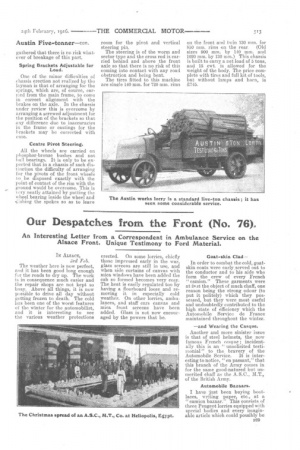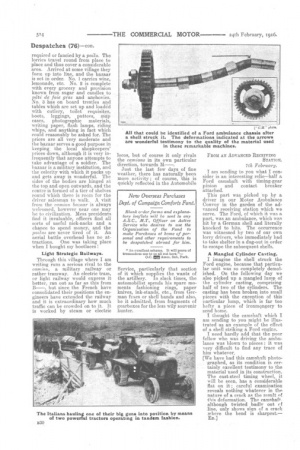Our Despatches from the Front (No. 76).
Page 7

Page 8

If you've noticed an error in this article please click here to report it so we can fix it.
An Interesting Letter from a Correspondent in Ambulance Service on the Alsace Front. Unique Testimony to Ford Material.
IN ALSACE,
3rd Feb.
The weather here is now perfect, and it has been good long enough for the roads to dry up. The work is in consequence much easier and the repair shops are not kept se busy. Above all things, it is now possible to drive all day without getting frozen to death. The cold has been one of the worst features of the winter for the automobilist, and it is interesting to see the various weather protections erected. On some lorries, chiefly those impressed early in the war, glass screens are still in use, and when side curtains of canvas with mica windows have been added the cab so formed becomes very cosy. The heat is easily regulated too by having a floorboard loose and removing it in especially cold weather. On other lorries, ambulances, and staff cars canvas and mica front screens have been added. Glass is not now encouraged by the powers that be.
Goat-skin Clad— In order to combat the cold, goatskin coats were early.served out to the conductor and to his aide who form the crew of every French " camion." These garments were at fi.st the object of much chaff, one reason being the strong odour (to put it politely) which they possessed, but they were most useful and undoubtedly contributed to the high state of efficiency which the Automobile Service de France maintained throughout the winter.
—and Wearing the Casque.
Another and more sinister issue is that of steel helmets, the now famous French eetsque ; incidentally this is an " unsolicited testimonial" to the bravery of the Automobile Service. It is interesting to notice, " en passant," that this branch of the Army conies in for the same good-natured but unmerited chaff as the A.S.C., M.T., of the British Army.
Automobile Bazaars.
I have .just been buying bootlaces, writing paper, etc., at a " camion bazaar. This consists of three Peugeot lorries equipped with special bodies and every imaginable article which could possibly be
required or fancied by a poila. The lorries travel round from place to plate and thus cover a considerable area. Arrived at some village they form up into line, and the bazaar is set in order. No. I carries wine, lemonade, etc. No. 2 is complete with every grocery and provision known from sugar and candles to pâté de foie gras and anchovies. No. 3 has on board trestles and tables which are set up and loaded with cutlery, toilet requisites, boots, leggings, puttees, ms‘P cases, photographic materials, writing paper, flash lamps, riding whips, and anything in fact which could reasonably be asked for. The prices are all very moderate and the bazaar serves a good purpose in keeping the local shopkeepers' prices down, although it is very infrequently that anyone attempts to take advantage of a soldier. The bazaar is a military institution, and the celerity with which it packs up and gets away is wonderful. The sides of the bodies are hinged at the top and open outwards, and the centre is formed of a tier of shelves round which there is room for the driver salesman to walk. A visit from the camion bazaar is always welcomed, however near one may be to civilization. Mess presidents find it invaluable, officers find all sorts of useful nick-nacks and a chance to spend money, and the roitus are never tired of it. An aerial battle overhead has no attractions. One was taking place when I bought my bootlaces
Light Strategic Railways.
Through this village where I am writing runs a serious rival to the cam ion, a military railway or rather tramway. An electric tram, or light railway would express it better, ran out as far as this from B—, but since the French have consolidated their positions the engineers have extended the railway and it is extraordinary how much traffic can be crowded on to it. Ti is worked by steam or electric locos, but of course it only rivals the minions in its own particular direction, towards II—.
Just the last few days of fine weather, there has naturally been more activity ; of course, this is quickly reflected in the Automobile Service, particularly that section of it which supplies the wants of the artillery. In slack times, the automobilist spends his spare moments fashioning rings, paper knives, ink-stands, etc., from German fuses or shell bands and also, be it admitted, from fragments of gearboxes for the less wily souvenir hunter. FROM AN ADVANCED RECEIVING STATION.
7th February.
am sending to you what I consider is an interesting relic—half a Ford camshaft with timing-gear pinion and contact breaker attached.
This part was picked up by a driver in our Motor Ambulance Convoy in the garden of the advanced receiving station which we serve. The Ford, of which it was a part, was an ambulance, which was hit by a German shell and literally knocked to bits. The occurrence was witnessed by two of our own lorry drivers, who immediately had to take shelter in a dug-out in order to escape the subsequent shells.
A Mangled Cylinder Casting.
I imagine the shell struck the Ford engine, because that particular unit was so completely demolished. On the following day we also picked tip a mangled lump of the cylinder casting, comprising half of two of the cylinders. The casting has been broken into small pieces with the exception of this particular lump, which is far too hefty a piece of ironingngery to send home.
I thought the camshaft which I am sending to you might he illustrated as an example of the effect of a shell striking a Ford engine. • I need hardly add that the poor fellow who was driving the ambulance was blown to pieces ; it was very difficult to find any trace of him whatever.
[We have had this camshaft photographed, as its condition is certainly excellent testimony to the material used in its construction. The cast-steel timing wheel, it will be seen, has a considerable flat on it • careful examination reveals nothing whatever in thc nature of a crack as the result of this deformation. The camshaft although twisted badly out cf line, only shows sign of a crack where the bend is sharpest— En.




















